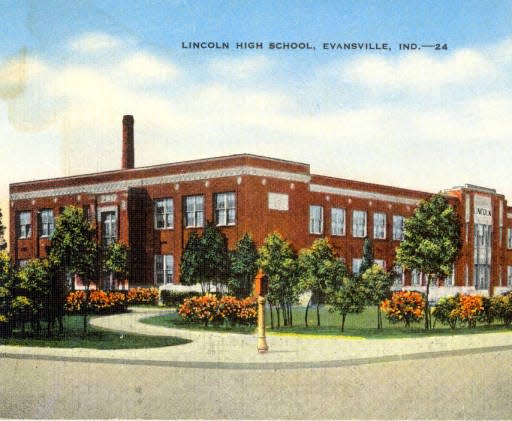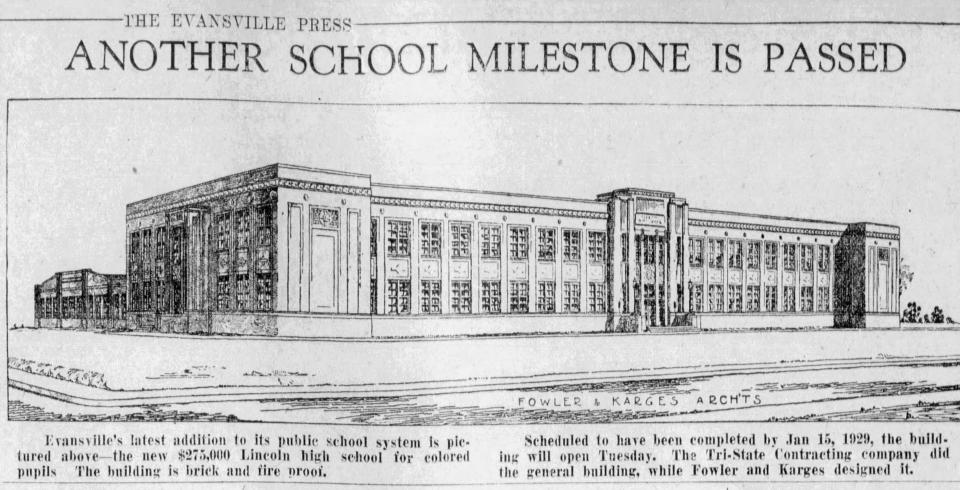Black History: Lincoln School was a powerhouse in athletics

Editor's note: The Courier & Press and The Gleaner are marking Black History Month with a collection of stories about people, places and events from local Black history.
EVANSVILLE — The first new school built in Evansville for the Black community, local historians called it.
Lincoln School opened in 1928, the same decade that saw Ku Klux Klan members win the Indiana governor's office and more than half the seats in the Legislature. Segregation was the law of the land. Lincoln was built to educate Evansville’s Black youth and, because it was the only Black high school in the area, kids from Mount Vernon, Rockport, Newburgh and Grandview were bussed into town to attend Lincoln.
It was one of the state’s three segregated high schools, along with Crispus Attucks in Indianapolis and Roosevelt in Gary. It also lacked many of the advantages the bigger and better-funded white schools in town enjoyed.
Lincoln School today is a public K-8 institution that feeds into Central High. But the trophy case sitting past the lobby and pictures hanging in the hall keep history on display. Lincoln won a national boys’ basketball championship, the city’s lone. The Lincoln Lions were perennially a powerhouse in state, regional and national competition among Black high schools.
Lincoln became the city’s first team to finish a regular season undefeated. The Lions also won the school’s first sectional championship. That was the same season Oscar Robertson led Attucks to back-to-back state titles. Lincoln repeated the next year and won a regional, too, before claiming another sectional in ‘60. Those high-powered Lions teams often scored 100 points per game.
Some of Lincoln's athletes took their success to the next level — and the next level after that.

Former Lincoln class president John Barnhill (’55) played basketball collegiately at Tennessee State and won NAIA championships in ‘57, ‘58 and ’59. He was chosen in the 11th round of the ’59 NBA Draft and spent 10 seasons with St. Louis, Detroit and Baltimore. He later played in the rival ABA for the Indiana Pacers. In the 70s, after his playing days finished, he was the Los Angeles Lakers’ Director of Player of Personnel.
In football, quarterback Calvin Martin (’45) played at Maryland State in college and was a backup for the NFL's Detroit Lions before finishing in the Canadian Football League. His teammate William Saucer (’46) became the first black football player at Evansville College.
Sports were a rallying point during a time when Blacks couldn’t frequent all the same restaurants and shops as whites. Lincoln students learned not just to stand tall on the court, but to stand tall at all times.

But standing tall wasn’t always easy when segregation and prejudice were rampant. Lincoln was forbidden to compete against white teams in contact sports like basketball and football until 1943, when the Indiana Legislature forced the Indiana High School Athletic Association to open its membership to all schools.
Even then, it took until 1949 for local Catholic schools Rex Mundi, Mater Dei and Memorial to schedule the Lions. The public schools didn’t budge. Although state law opened all schools to African-Americans in ‘49, black students remained at Lincoln because they lived nearby. A few integrated into Bosse and Central in the early 50s, but they were the exception.
The last all-Black Lincoln High School class was graduated in June 1962. Lincoln transitioned to K-8 that year.
This article originally appeared on Evansville Courier & Press: Black History: Evansville's Lincoln School was a powerhouse in athletics

